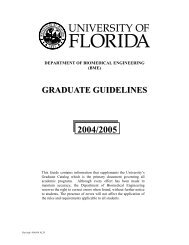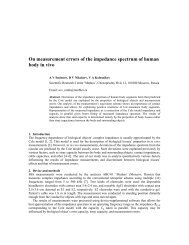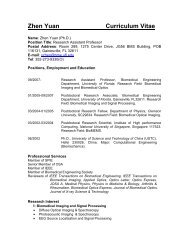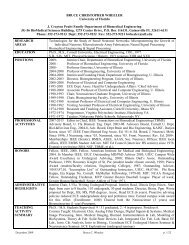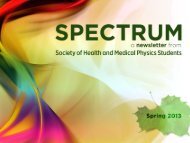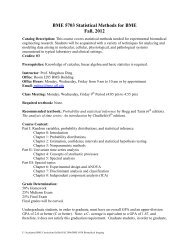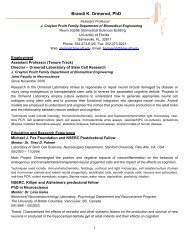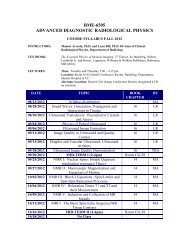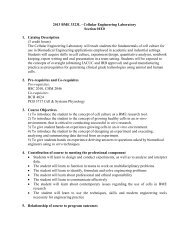Electric Impedance Imaging of the Mammary Gland in the Case of ...
Electric Impedance Imaging of the Mammary Gland in the Case of ...
Electric Impedance Imaging of the Mammary Gland in the Case of ...
Create successful ePaper yourself
Turn your PDF publications into a flip-book with our unique Google optimized e-Paper software.
<strong>Electric</strong> <strong>Impedance</strong> <strong>Imag<strong>in</strong>g</strong> <strong>of</strong> <strong>the</strong> <strong>Mammary</strong> <strong>Gland</strong> <strong>in</strong> <strong>the</strong><strong>Case</strong> <strong>of</strong> MastitisM Korotkova 1,2 , A Karpov 1,21 Cl<strong>in</strong>ical Hospital 9, Yaroslavl, Russia2 “SIM Technika” PKF, Yaroslavl, RussiaE-mail: kb9@mail.rusim-tech@net76.ruAbstract. The electric impedance mammography technique has been applied for several years.The aim <strong>of</strong> <strong>the</strong> research <strong>in</strong> hand is to reveal <strong>the</strong> peculiarities <strong>of</strong> <strong>the</strong> electric impedance imag<strong>in</strong>g<strong>in</strong> various stages <strong>of</strong> <strong>the</strong> <strong>in</strong>flammatory process <strong>in</strong> <strong>the</strong> mammary gland. We have conducted anexam<strong>in</strong>ation <strong>of</strong> twenty six patients: five <strong>of</strong> <strong>the</strong>m <strong>in</strong> <strong>the</strong> stage <strong>of</strong> arterial hyperemia, eight <strong>in</strong> <strong>the</strong>stage <strong>of</strong> <strong>in</strong>filtration, three <strong>of</strong> <strong>the</strong>m <strong>in</strong> <strong>the</strong> stage <strong>of</strong> abscess and ten <strong>in</strong> <strong>the</strong> stage <strong>of</strong> cicatrization.The exam<strong>in</strong>ation was carried out on <strong>the</strong> “MEIK” (version 5.6) potencial electric impedancecomputer mammograph. The weighted reciprocal projection method was used to reconstruct<strong>the</strong> 3-D electric conductivity distribution <strong>of</strong> <strong>the</strong> exam<strong>in</strong>ed organ. Any <strong>in</strong>flammatory process isphasic and always attended by <strong>the</strong> complex vascular alterations with exudation <strong>of</strong> liquidcomponents <strong>of</strong> plasma, blood cells outwander<strong>in</strong>g and stromal cells proliferation.Pathophysiological and histopathological peculiarities <strong>of</strong> each stage <strong>of</strong> <strong>the</strong> <strong>in</strong>flammatoryprocess are well reflected <strong>in</strong> <strong>the</strong> electric impedance images. This fact enabled <strong>the</strong> authors <strong>of</strong> <strong>the</strong>research to def<strong>in</strong>e <strong>the</strong> electric impedance imag<strong>in</strong>g as <strong>the</strong> hist<strong>of</strong>unctional scann<strong>in</strong>g.1. Introduction<strong>Electric</strong> impedance potential mammography method has been applied <strong>in</strong> <strong>the</strong> obstetric division <strong>of</strong>Cl<strong>in</strong>ical Hospital 9 (Yaroslavl) for several years already. The most commonly encountered mammarygland pathology <strong>in</strong> <strong>the</strong> per<strong>in</strong>atal period is <strong>in</strong>flammation – mastitis. Inflammation (Lat. <strong>in</strong>flammatio –ignite, set on fire) - pathological process characterized by <strong>the</strong> development <strong>of</strong> local alterative, vascularand proliferative reactions <strong>of</strong> an organism to ill effects. In <strong>the</strong> <strong>in</strong>flammatory process <strong>the</strong> follow<strong>in</strong>gstages are dist<strong>in</strong>guished: alteration, disturbed circulation and microcirculation, proliferation [1, 2, 3].The research <strong>in</strong> hand aims to reveal <strong>the</strong> peculiar features <strong>of</strong> <strong>the</strong> mammary gland electric impedanceimage <strong>in</strong> different stages <strong>of</strong> <strong>the</strong> <strong>in</strong>flammatory process.2. Methods and MaterialsWe have conducted an exam<strong>in</strong>ation <strong>of</strong> 26 patients, 5 <strong>of</strong> <strong>the</strong>m - <strong>in</strong> <strong>the</strong> stage <strong>of</strong> active (arterial)hyperemia, 8 - <strong>in</strong> <strong>the</strong> stage <strong>of</strong> <strong>in</strong>filtration, 3 – <strong>in</strong> <strong>the</strong> stage <strong>of</strong> abscess formation, 10 - <strong>in</strong> <strong>the</strong> stage <strong>of</strong>cicatrization (scarr<strong>in</strong>g). The exam<strong>in</strong>ation was carried out on <strong>the</strong> electric impedance computermammograph “MEIK” v.5.6, <strong>in</strong> which modificated backprojection method is used to reconstruct <strong>the</strong>image (50 kHz, 0.5 mA). The computational result <strong>of</strong> surface <strong>in</strong>tensity for <strong>the</strong> data acquired on ahomogenious object was used as <strong>the</strong> referential measurement. Throughout <strong>the</strong> <strong>in</strong>strumentality <strong>of</strong> <strong>the</strong>semeasurements <strong>the</strong> electical conductivity <strong>in</strong>dex was calculated (expressed <strong>in</strong> conditional units). When<strong>the</strong> reconstruction is f<strong>in</strong>ished, seven consecutive scan planes are created, which correspond to sections
In <strong>the</strong> electric impedance mammograms <strong>in</strong>filtrate can be visualized as a homogeneous well-def<strong>in</strong>edhyperimpedance area with low conductivity <strong>in</strong>dex (Figure 2). The histogram <strong>of</strong> electrical conductivitydistribution dur<strong>in</strong>g <strong>the</strong> stage <strong>of</strong> <strong>in</strong>flammation process usually has unimodal asymmetric shape (Figure2). The difference between <strong>the</strong> mean electrical conductivity <strong>in</strong>dex and <strong>the</strong> mode as well as <strong>the</strong> shape <strong>of</strong>Figure 2. Disturbed circulation and microcirculation stage. Infiltration. The homogeneoushyperechoic mass can be visualized (1-4 scan planes) over an area from 7 to 9 on <strong>the</strong> clock dial (<strong>the</strong>first row - scann<strong>in</strong>g planes, <strong>the</strong> second row - electroimpedance tomograms, <strong>the</strong> third row –histogram <strong>of</strong> electroconductivity distribution, <strong>the</strong> fourth row – qualitative assessment, on <strong>the</strong> right –conductivity scale).<strong>the</strong> histogram depends on <strong>the</strong> distribution <strong>of</strong> <strong>the</strong> <strong>in</strong>filtrate. When <strong>in</strong>flammation makes progress,leukocytoclasis and pus formation take place [2]. These processes result <strong>in</strong> decrease <strong>of</strong> reactivecomponent <strong>of</strong> impedance and <strong>in</strong> <strong>in</strong>crease <strong>of</strong> conductivity <strong>in</strong> <strong>the</strong> abscess formation area. Cl<strong>in</strong>ically,abscess formation manifests itself <strong>in</strong> s<strong>of</strong>ten<strong>in</strong>g <strong>of</strong> <strong>the</strong> <strong>in</strong>flamed area. Leukocytic <strong>in</strong>filtrate loses itshyperimpedance homogeneousness.Clusters <strong>of</strong> pus manifest <strong>the</strong>mselves by high conductivity. In <strong>the</strong> electric impedance mammograms<strong>the</strong> process <strong>of</strong> pyogenic dissolution <strong>of</strong> <strong>in</strong>filtrate is accompanied by <strong>the</strong> loss <strong>of</strong> homogeneity and by <strong>the</strong>emergence <strong>of</strong> hypoimpedance areas with high conductivity <strong>in</strong>dex correspond<strong>in</strong>g with <strong>the</strong> location <strong>of</strong>pus clusters (Figure 3). The difference between <strong>the</strong> mean electrical conductivity <strong>in</strong>dex and <strong>the</strong> mode issignificant. The histogram <strong>of</strong> electrical conductivity distribution dur<strong>in</strong>g <strong>the</strong> abscess formation has amultimodal shape.Figure 3. Disturbed circulation and microcirculation stage. Abscess formation. A heterogeneousimpedancee structure with a hypoimpedance part <strong>in</strong> its center can be visualized (1-3 scan planes) overa vast area from 12 to 4 on <strong>the</strong> clock dial (<strong>the</strong> first row - scann<strong>in</strong>g planes, <strong>the</strong> second row -electroimpedance tomograms, <strong>the</strong> third row – histogram <strong>of</strong> electroconductivity distribution, <strong>the</strong> fourthrow – qualitative assessment, on <strong>the</strong> right – conductivity scale).
3.3 Proliferation StageProliferation is <strong>the</strong> last stage <strong>of</strong> <strong>the</strong> <strong>in</strong>flammation process. Dur<strong>in</strong>g <strong>in</strong>flammation <strong>the</strong> tissue alwaysdissolves to a greater or lesser extent. The dissolution which is caused by <strong>the</strong> <strong>in</strong>flammation processand f<strong>in</strong>ished dur<strong>in</strong>g <strong>the</strong> <strong>in</strong>filtration stage, ends with <strong>the</strong> complete recovery <strong>of</strong> damaged tissue structuresand thus does not lead to dysfunction [1, 2]. Infiltrate regression is accompanied by its substitution byconnective tissues and by <strong>the</strong> recovery <strong>of</strong> electrical properties <strong>of</strong> damaged tissues.The dissolution <strong>of</strong> tissues reaches its maximum <strong>in</strong> <strong>the</strong> case <strong>of</strong> suppurative <strong>in</strong>flammation. A cavity isformed <strong>in</strong> <strong>the</strong> place <strong>of</strong> <strong>the</strong> former <strong>in</strong>flammation. In what follows, this tissue defect gradually fills <strong>in</strong> at<strong>the</strong> expense <strong>of</strong> growth <strong>of</strong> local cells <strong>of</strong> <strong>the</strong> connective tissue – fibroblasts, but tissue structures andfunctions recovery never takes place. When defect heal<strong>in</strong>g by primary <strong>in</strong>tention, <strong>the</strong> cicatrix is formedwhich fully consists <strong>of</strong> collagen fibers [1, 2]. In <strong>the</strong> electric impedance mammograms a cicatrix can bevisualized as a hyperimpedance <strong>of</strong>ten irregular-shaped strip, it possesses low conductivity <strong>in</strong>dex(Figure 4).Figure 4. <strong>Electric</strong> impedance images <strong>of</strong> <strong>the</strong>mammary gland (3 scan planes).In <strong>the</strong> centralupper area one observes a hyperimpedancel<strong>in</strong>ear zone which correponds with <strong>the</strong> realscar <strong>in</strong> shape and size.Figure 5. <strong>Electric</strong> impedance images <strong>of</strong> <strong>the</strong>mammary gland (3 scan planes). In <strong>the</strong> centralupper area one observes a hyperimpedancel<strong>in</strong>ear zone which corresponds with <strong>the</strong> realscar <strong>in</strong> shape and size.When heal<strong>in</strong>g by <strong>the</strong> second <strong>in</strong>tention, <strong>the</strong> defect is articulated from <strong>the</strong> rest <strong>of</strong> <strong>the</strong> tissue bycollagen fibers, and <strong>the</strong> nidus itself consists <strong>of</strong> amorphous substance <strong>of</strong> <strong>the</strong> connective tissue [1, 2]. Inthis case <strong>the</strong> cicatrix is visualized as hyperimpedance strips with low conductivity <strong>in</strong>dex and anisompedance area with medium conductivity <strong>in</strong>dex which is located between <strong>the</strong> stripes (Figure 5).The difference between <strong>the</strong> mean electrical conductivity <strong>in</strong>dex and <strong>the</strong> mode is m<strong>in</strong>imal. Thehistogram <strong>of</strong> electrical conductivity distribution dur<strong>in</strong>g <strong>the</strong> proliferation stage has a unimodalsymmetrical shape.4. ConclusionPathophysiological stages <strong>of</strong> <strong>the</strong> <strong>in</strong>flammation process are accompanied by <strong>the</strong> alteration <strong>of</strong> <strong>the</strong>electrical properties <strong>of</strong> damaged tissues <strong>of</strong> <strong>the</strong> mammary gland. Stage-dependent alterations <strong>of</strong> <strong>the</strong>electrical properties <strong>of</strong> mammary gland tissues def<strong>in</strong>e <strong>the</strong> peculiar features <strong>of</strong> <strong>the</strong> mammary glandelectric impedance image. That is why electric impedance mammography method can be def<strong>in</strong>ed as amethod <strong>of</strong> hist<strong>of</strong>unctional scann<strong>in</strong>g. The imag<strong>in</strong>g <strong>of</strong> different <strong>in</strong>flammation process stages by means <strong>of</strong>electrical impedance tomograms allows us<strong>in</strong>g this method to diagnose mastitis, choice <strong>of</strong> treatmentand its monitor<strong>in</strong>g.5. References1. Afanasiev I 2002 Histology, Citology and Embriology Moscow pp 199-223 719-7252. Ado A 1973 Physiopathology Moscow pp 160-1753. Trufanov G 2006 Radiodiagnostics <strong>of</strong> diseases <strong>the</strong> mammary gland St Petersburg pp 105-117



